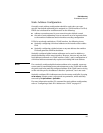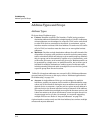
3-14
IPv6 Addressing
Link-Local Unicast Address
Because all VLANs configured on the switch use the same MAC address, all
automatically generated link-local addresses on the switch will have the same
link-local address. However, since the scope of a link-local address includes
only the VLAN on which it was generated, this should not be a problem.
For example, executing ipv6 address dhcp full on a VLAN for which IPv6 was
not previously configured does all of the following:
■ enables IPv6 on the VLAN
■ causes the switch to generate a stateless link-local unicast address on the
VLAN
■ configures the VLAN to send DHCPv6 requests
Note Only one link-local unicast address can exist on a VLAN interface at any time.
Configuring a new address of this type on an interface on which IPv6 is already
enabled replaces the previously existing link-local address with the new one.
Any link-local address must include the well-known link-local prefix
fe80::/64 plus a 64-bit device identifier.
Any of the following commands enable IPv6 on a VLAN and automatically
generate a link-local address:
■ ipv6 enable (page 4-6)
■ ipv6 address autoconfig (page 4-7)
■ ipv6 address dhcp full [rapid-commit] (page 4-9)
■ ipv6 address < network-prefix><device-id >/< prefix-length > (page 4-13)
Extended Unique Identifier (EUI)
When the link-local address is automatically generated, the device identifier
is derived from the switch's 48- bit (hexadecimal) MAC address to create a 64-
bit Extended Unique Identifier (EUI) to be appended to the fe80 link-local
prefix, as follows:
■ ff-fe is inserted between third and fourth bytes of MAC address
■ The second low-order bit (the Universal/Local bit) in the first byte of the
MAC address is complemented, which usually means the bit is originally
set to 0 and is changed to 1. This indicates a globally unique IPv6 interface
identifier. For example:


















